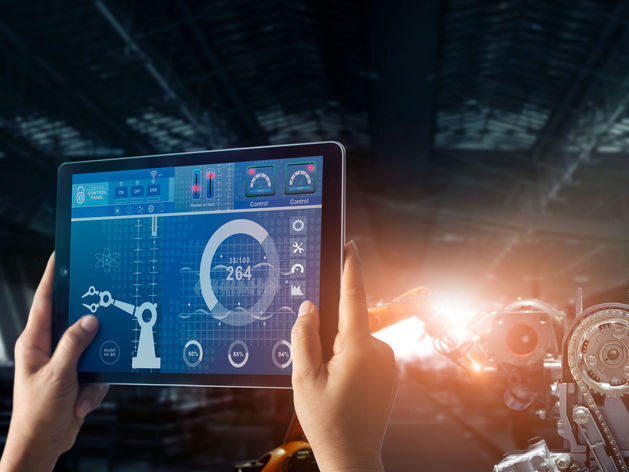The Next Wave: Industry 5.0 Encourages Human-Centric Automation
By now most manufacturers are familiar with and, likely, active participants in Industry 4.0, which combines Internet of Things (IoT)-based technologies, automation and data analysis to squeeze every last drop of productivity from the factory. The next wave – the Fifth Industrial Revolution (Industry 5.0) – builds upon this foundation of sensors, automation and Big Data, but also applies a strong focus on human-centric automation. The goal of human-centric automation, or close collaborations between human workers and automation technologies, is to provide more value-added services that encourage manufacturers to become not only efficient, but also more agile and resilient.

What is Human-Centric Automation?
The emerging term, human-centric automation, describes a close collaboration between the intelligence of human operators and the effectiveness of automated systems in an effort to reduce the limitations of each and improve the performance of the manufacturing process, as well as the customer and employee experience. In humans, strengths include complex problem solving and creative thinking capabilities, while confines might include fatigue, boredom and physical injury. In automation technologies, advantages include speed and accuracy, while disadvantages involve the inability to perform complex tasks or those that require agile problem solving. Human-centric automation aims to harness and combine the strengths of humans and machines in an effort to mitigate the weaknesses with the ultimate goal of not just improving the manufacturing process, but also customer and employee satisfaction.
In human-centric automation, human operators focus on monitoring, controlling, engineering, programming and maintaining automation technologies so that they may make timely decisions and identify solutions that increase not only efficiency, quality and accuracy of the process, but also resiliency of the business. As part of the human-centric approach, lower-skilled workers will develop engineering and programming skills, adding more value to the organization and allowing manufacturers to become more agile.
As part of the evolution, anticipated advances in connectivity, machine learning, artificial intelligence (AI) and virtual reality will build upon the foundation of today’s Industry 4.0-based technologies and allow human workers to better collaborate and communicate with automated equipment. When combined, the ability of humans to evaluate situations and identify solutions and more easily communicate, control and collaborate with automated equipment opens the door to more manufacturing resiliency as humans can solve complex problems related to process or supply chain disruptions and/or changing or customized orders and then control the automation to ensure that the process meets the necessary parameters.
Industry 5.0 aims to build upon the technologies associated with Industry 4.0 to better support human creativity, increase job satisfaction and meet the changing manufacturing dynamic toward more customized products, while still increasing efficiency and bettering the bottom line. In other words, instead of focusing on the speed at which automation can mass produce a product without human assistance, Industry 5.0 recognizes the value of the complex, critical and creative thinking skills of humans and uses it to enhance the accuracy and efficiency of robots with the ultimate goal of attracting and retaining skilled workers, providing manufacturing resiliency and agility and satisfying consumers who crave a more personalized product.
Tools for Human-Centric Automation
Because human-centric automation aims to provide more meaningful collaboration between humans and automation, the digital and automated technologies of Industry 4.0 will play a large part in offering real-time data to boost efficiency, but also will deliver more personalized and valuable offerings. Here are several technologies you can expect to see play a starring role in Industry 5.0:
| Collaborative Robots | Already designed to safely work alongside manual laborers, collaborative robots improve processes and productivity with high speeds and accuracy. In a human-centric approach, collaborative robots will enhance human-based creativity, problem-solving skills and craftsmanship with their inherent speed and accuracy, allowing even handcrafted or customized items to be produced in greater quantities. Collaborative robots can be taught new skills quickly and work with human operators to adapt to changes in production, providing greater agility and flexibility on the factory floor. |
| Smart Sensors | By using smart sensors that are embedded in the process or on equipment, human workers can easily and accurately monitor the process or equipment and make adjustments based on information provided by the sensors. Sensors may also be applied to collaborative robots to enhance safety when working in close proximity to human operators and can be combined with machine learning technologies to facilitate training of collaborative robots to enhance agility and flexibility. |
| Advanced Data Analytics | Data analytics programs will continue to provide actionable data to operators who will be encouraged to use complex problem-solving skills to recognize issues within the production process and take action to guide the process back to specification. Advanced analytics can also be used to alert human operators to issues with manufacturing equipment or the supply chain that may impact throughput. Human workers can combine this information with their own intelligence and experience to determine what must be done to rectify the situation and collaborate with equipment to adapt to necessary changes. Data analytics may also be used to analyze customer inputs to predict seasonal or customized product demands that may require changes to the production schedule or the process itself. |
| Advanced Controls | Collaboration between man and machine will become easier and more intuitive via advanced controls and human machine interfaces that easily communicate with automated equipment when there is an emergency, a change in production or a problem with the process, promoting manufacturing agility. |
| Artificial Intelligence and Machine Learning | These advanced technologies may be embedded in collaborative robots, traditional robots and other automated equipment to further facilitate human-centric automation and collaboration between man and machine. AI and machine learning will make it easier for collaborative robots to learn from human operators, recognize issues and respond under the guidance of human operators. They can also be used to understand and learn about customer preferences and demands and support necessary changes to the production process. |
As manufacturers must continue to increase efficiency and throughput, provide more customized products and adapt to supply chain disruptions, while struggling to retain employees, Industry 5.0 with its human-centric approach to automation can help them remain competitive as it aims to build upon existing technologies to boost employee satisfaction, provide customers with customized products and increase manufacturing agility, while still meeting traditional efficiency goals. For more information on implementing the building blocks of human-centric automation, please contact an expert at JHFOSTER.
